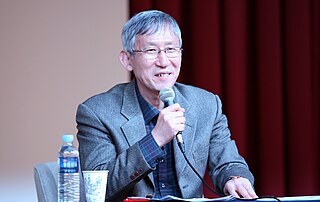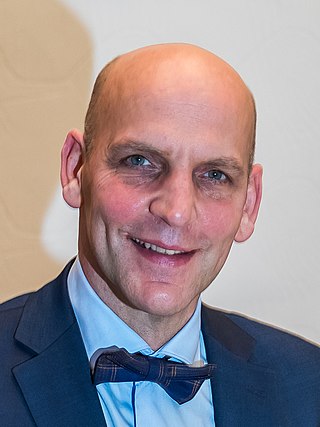Related Research Articles
In chemistry, a nitrene or imene is the nitrogen analogue of a carbene. The nitrogen atom is uncharged and univalent, so it has only 6 electrons in its valence level—two covalent bonded and four non-bonded electrons. It is therefore considered an electrophile due to the unsatisfied octet. A nitrene is a reactive intermediate and is involved in many chemical reactions. The simplest nitrene, HN, is called imidogen, and that term is sometimes used as a synonym for the nitrene class.

Aziridines are organic compounds containing the aziridine functional group, a three-membered heterocycle with one amine (-NR-) and two methylene bridges. The parent compound is aziridine, with molecular formula C
2H
4NH. Several drugs feature aziridine rings, including mitomycin C, porfiromycin, and azinomycin B (carzinophilin).
A carbometalation is any reaction where a carbon-metal bond reacts with a carbon-carbon π-bond to produce a new carbon-carbon σ-bond and a carbon-metal σ-bond. The resulting carbon-metal bond can undergo further carbometallation reactions or it can be reacted with a variety of electrophiles including halogenating reagents, carbonyls, oxygen, and inorganic salts to produce different organometallic reagents. Carbometalations can be performed on alkynes and alkenes to form products with high geometric purity or enantioselectivity, respectively. Some metals prefer to give the anti-addition product with high selectivity and some yield the syn-addition product. The outcome of syn and anti- addition products is determined by the mechanism of the carbometalation.
In chemistry, bis(oxazoline) ligands (often abbreviated BOX ligands) are a class of privileged chiral ligands containing two oxazoline rings. They are typically C2‑symmetric and exist in a wide variety of forms; with structures based around CH2 or pyridine linkers being particularly common (often generalised BOX and PyBOX respectively). The coordination complexes of bis(oxazoline) ligands are used in asymmetric catalysis. These ligands are examples of C2-symmetric ligands.

The Liebeskind–Srogl coupling reaction is an organic reaction forming a new carbon–carbon bond from a thioester and a boronic acid using a metal catalyst. It is a cross-coupling reaction. This reaction was invented by and named after Jiri Srogl from the Academy of Sciences, Czech Republic, and Lanny S. Liebeskind from Emory University, Atlanta, Georgia, USA. There are three generations of this reaction, with the first generation shown below. The original transformation used catalytic Pd(0), TFP = tris(2-furyl)phosphine as an additional ligand and stoichiometric CuTC = copper(I) thiophene-2-carboxylate as a co-metal catalyst. The overall reaction scheme is shown below.
Electrophilic amination is a chemical process involving the formation of a carbon–nitrogen bond through the reaction of a nucleophilic carbanion with an electrophilic source of nitrogen.
The Tsuji–Trost reaction is a palladium-catalysed substitution reaction involving a substrate that contains a leaving group in an allylic position. The palladium catalyst first coordinates with the allyl group and then undergoes oxidative addition, forming the π-allyl complex. This allyl complex can then be attacked by a nucleophile, resulting in the substituted product.
Asymmetric ion-pairing catalysis in chemistry is a type of asymmetric catalysis taking place specifically with charged intermediates or charged reagents. In one type of catalysis ion-pairing exists with a charged and chiral catalyst. The charged catalyst can be cationic or anionic. Catalysis by anionic catalysts is also called asymmetric counteranion-directed catalysis. In the other variation of asymmetric ion-pairing catalysis called anion or cation binding, the chiral catalyst is neutral but binds in a noncovalent way to an intermediate ion pair. Asymmetric ion-pairing catalysis is distinct from other covalent types of catalysis such as Lewis acid catalysis and Bronsted acid catalysis. It is one of several strategies in enantioselective synthesis and of some relevance to academic research.
Cobalt(II)–porphyrin catalysis is a process in which a Co(II) porphyrin complex acts as a catalyst, inducing and accelerating a chemical reaction.
Clark Landis is an American chemist, whose research focuses on organic and inorganic chemistry. He is currently a Professor of Chemistry at the University of Wisconsin–Madison. He was awarded the ACS Award in Organometallic Chemistry in 2010, and is a fellow of the American Chemical Society and the American Association for the Advancement of Science.
Sarah Elizabeth Reisman is a Chemistry Professor at the California Institute of Technology. She received the (2013) Arthur C. Cope Scholar Award and the (2014) Tetrahedron Young Investigator Award for Organic Synthesis. Her research focuses on the total synthesis of complex natural products.
Corinna S. Schindler is a Professor of Chemistry at the University of Michigan. She develops catalytic reactions with environmentally benign metals such as iron, towards the synthesis of biologically active small molecules. For her research in the development of new catalysts, Schindler has been honored with several early-career researcher awards including the David and Lucile Packard Foundation Fellowship in 2016, the Alfred P. Sloan Fellowship in 2017, and being named a member of the C&EN Talented 12 in 2017. Schindler has served on the Editorial Board of Organic and Bimolecular Chemistry since 2018.

Sukbok Chang is a South Korean organic chemist. He is a distinguished professor in the Department of Chemistry at Korea Advanced Institute of Science and Technology (KAIST). He is also the director of the Institute for Basic Science (IBS) Center for Catalytic Hydrocarbon Functionalizations (CCHF). He was an associate editor on ACS Catalysis and has served on the editorial advisory boards of The Journal of Organic Chemistry, Journal of the American Chemical Society, and Accounts of Chemical Research. His major research interest is transition metal catalyzed C-H bond functionalization for the carbon-carbon bond and carbon-heteroatom bond formation.
Ellen Sletten is an American chemist who is the John McTague Career Development Chair at University of California, Los Angeles. Her research considers the use of physical organic chemistry for diagnostics and medical therapies.
Cristina Nevado is a Spanish chemist who is a Professor of Organic Chemistry at the University of Zurich. Her research considers chemical synthesis and organometallic reactions. She received the 2021 Margaret Faul Women in Chemistry Award.
T.V. (Babu) RajanBabu is an organic chemist who holds the position of Distinguished Professor of Chemistry in the College of Arts and Sciences at the Ohio State University. His laboratory traditionally focuses on developing transition metal-catalyzed reactions. RajanBabu is known for helping develop the Nugent-RajanBabu reagent, a chemical reagent used in synthetic organic chemistry as a single electron reductant.

Benjamin List is a German chemist who is one of the directors of the Max Planck Institute for Coal Research and professor of organic chemistry at the University of Cologne. He co-developed organocatalysis, a method of accelerating chemical reactions and making them more efficient. He shared the 2021 Nobel Prize in Chemistry with David MacMillan "for the development of asymmetric organocatalysis".
An organic azide is an organic compound that contains an azide functional group. Because of the hazards associated with their use, few azides are used commercially although they exhibit interesting reactivity for researchers. Low molecular weight azides are considered especially hazardous and are avoided. In the research laboratory, azides are precursors to amines. They are also popular for their participation in the "click reaction" between an azide and an alkyne and in Staudinger ligation. These two reactions are generally quite reliable, lending themselves to combinatorial chemistry.
Jennifer Ann Prescher is an American chemist who is a professor of chemistry at the University of California, Irvine. Her research considers the development of bioorthogonal, bioluminescent tools for the noninvasive, real-time imaging of immunometabolism. She was recognized with the 2023 American Chemical Society Arthur C. Cope Scholar Award.
Alison Wendlandt is an American chemist who is an assistant professor at the Massachusetts Institute of Technology. Her research considers the development of catalysts for organic synthesis.
References
- ↑ Evans, David A.; Bilodeau, Mark T.; Faul, Margaret M. (April 1994). "Development of the Copper-Catalyzed Olefin Aziridination Reaction". Journal of the American Chemical Society. 116 (7): 2742–2753. doi:10.1021/ja00086a007. ISSN 0002-7863.
- ↑ Evans, David A.; Faul, Margaret M.; Bilodeau, Mark T.; Anderson, Benjamin A.; Barnes, David M. (June 1993). "Bis(oxazoline)-copper complexes as chiral catalysts for the enantioselective aziridination of olefins". Journal of the American Chemical Society. 115 (12): 5328–5329. doi:10.1021/ja00065a068. ISSN 0002-7863.
- ↑ Faul, Margaret (2017). "Faul biosketch" (PDF). Organic Syntheses. Archived from the original (PDF) on 21 July 2017. Retrieved 19 November 2018.
- ↑ Patel, Prachi (10 February 2017). "A Conversation with Margaret Faul". ACS Central Science. 3 (2): 141–142. doi:10.1021/acscentsci.7b00050. ISSN 2374-7943. PMC 5324089 . PMID 28280781.
- ↑ "Science of Synthesis Editorial Board - Thieme Chemistry - Georg Thieme Verlag". Thieme. Retrieved 19 November 2018.
- ↑ "Portrait of Dr. Margaret Faul - Thieme Chemistry - Georg Thieme Verlag KG". Thieme. Retrieved 19 November 2018.
- ↑ "Working Groups". ETC. Archived from the original on 19 November 2018. Retrieved 19 November 2018.
- ↑ "2019 ACS Fellows". American Chemical Society. Retrieved 12 August 2019.
- ↑ "Women in Chemistry Award - Thieme Chemistry - Georg Thieme Verlag KG". Thieme. Retrieved 19 November 2018.
- ↑ "Earle B. Barnes Award for Leadership in Chemical Research Management: Margaret M. Faul | January 8, 2018 Issue - Vol. 96 Issue 2 | Chemical & Engineering News". cen.acs.org. Retrieved 19 November 2018.
- ↑ "Amgen Wins the 2017 Green Chemistry Challenge Award". www.amgen.com. Retrieved 19 November 2018.